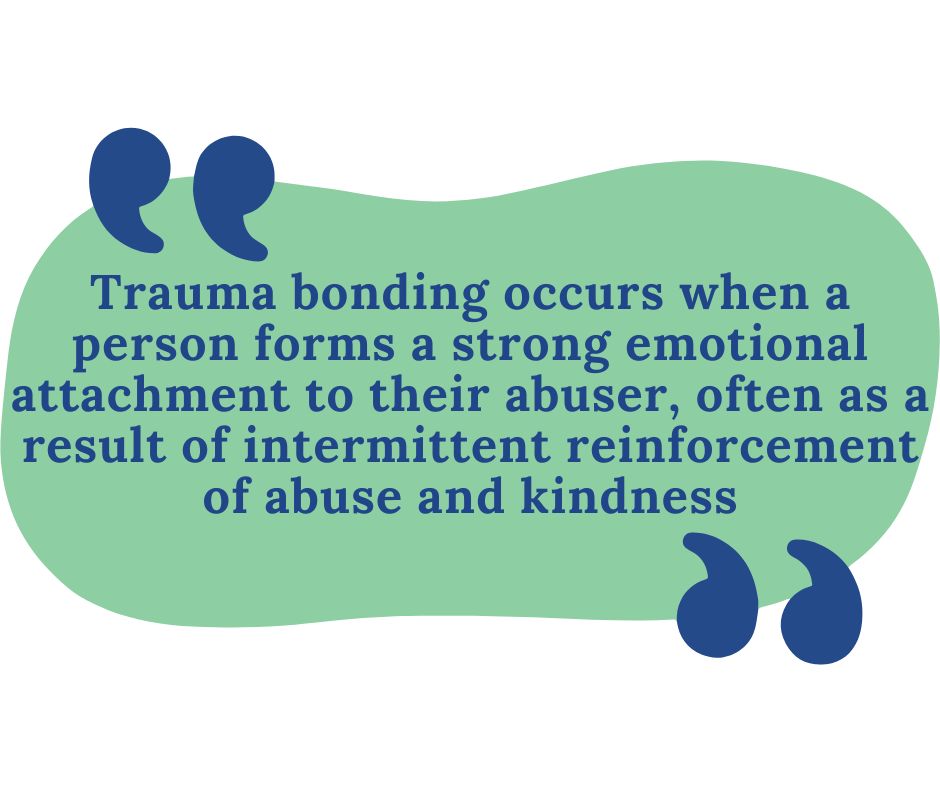What is Trauma Bonding: Understanding the Toxic Cycle of Abuse and Attachment
What is trauma bonding? Many people stay in harmful relationships without knowing why. They might feel stuck, scared, or unable to leave despite the pain they experience.
Trauma bonding happens when someone forms a deep emotional connection with a person who hurts them through a cycle of abuse, fear, and kindness. This attachment grows stronger when the abusive person switches between being cruel and loving, which creates confusion and dependence.
The bond can feel like love, but it comes from fear and survival instincts. People often mistake these intense feelings for a real connection, making it hard to recognize the unhealthy pattern and seek help.
Understanding Trauma Bonding
Trauma bonding creates a powerful emotional attachment between a person and their abuser through cycles of abuse and temporary kindness. This intense connection makes it difficult for victims to leave harmful relationships.
Definition and Origins
Trauma bonding happens when someone forms a deep emotional connection with a person who hurts them. The term came from Patrick Carnes in 1997 to describe why people stay in abusive relationships.
The bond grows stronger through repeated cycles. An abuser switches between being cruel and showing brief moments of love or kindness. These shifts leave victims confused and dependent.
People often mistake trauma bonds for true love. The irregular rewards of affection trigger the release of chemicals like dopamine and oxytocin in the brain, creating addiction-like symptoms.
Psychological Perspective
The psychology behind trauma bonding links to survival instincts. When faced with threats, people may attach to the source of danger as a way to stay safe.
This attachment stems from the brain’s stress response system. High levels of stress chemicals mix with pleasure chemicals during kind moments. The mix creates powerful emotional ties.
Many victims blame themselves for the abuse. They work harder to earn love and approval, which makes the bond grow stronger.
The body’s fight-or-flight response gets mixed up. Instead of running from danger, victims learn to seek comfort from the same person who causes their fear.
 Source: Carnes, P. J. (1997). The Betrayal Bond: Breaking Free of Exploitive Relationships. Hazelden Publishing.
Source: Carnes, P. J. (1997). The Betrayal Bond: Breaking Free of Exploitive Relationships. Hazelden Publishing.
Characteristics of Trauma Bonds: What is Trauma Bonding?
Trauma bonds develop specific patterns that make them different from healthy relationships. These bonds show distinct signs that make them challenging to break free from.
Emotional Connection
People in trauma bonds feel intense emotional highs and lows. The relationship creates strong feelings of love and fear at the same time.
The abused person often feels deep loyalty to their abuser. This loyalty stays strong even when others point out the harmful behavior.
When separated from the abuser, the victim experiences severe anxiety and distress. These feelings can be similar to drug withdrawal symptoms.
Cognitive Dissonance
The victim holds two opposing views of their abuser at once. They see them as both loving and cruel, helpful and harmful.
This mental conflict leads to confusion about what’s real. The victim often makes excuses for the abuser’s actions.
The person might deny or minimize the abuse they face. They focus on good memories while pushing away thoughts of bad experiences.
Cycle of Abuse
The abuse follows a predictable pattern: tension building, incident, reconciliation, and calm.
During calm periods, the abuser shows kindness and remorse. They might give gifts or make promises to change.
The victim starts to believe things will get better. This hope keeps them trapped in the cycle.
These peaceful times make it harder to leave. The good moments seem to outweigh the bad, even when abuse is frequent.
Breaking the Cycle
Breaking free from trauma bonds requires active steps and professional guidance to heal from unhealthy relationship patterns. Professional support and self-awareness play key roles in recovery.
Recognition and Acceptance
The first step is recognizing the signs of trauma bonding. Many people mistake intense emotional attachment for love, even when the relationship causes harm.
Warning signs include:
- Making excuses for abusive behavior
- Feeling unable to leave despite wanting to
- Defending the abuser to friends and family
- Believing things will change
Accepting that the relationship is unhealthy opens the door to healing. This means letting go of shame and understanding that trauma bonds can happen to anyone.
Seeking Support
Support systems are essential for breaking trauma bonds. Safe friends and family members can provide emotional backing and practical help.
A strong support network helps by:
- Offering a safe place to stay
- Listening without judgment
- Helping create safety plans
- Providing reality checks
Support groups connect people with others who share similar experiences. These groups reduce isolation and provide valuable coping strategies.
Therapeutic Interventions
Professional therapy helps identify and change unhealthy patterns. Trauma-informed therapists understand the complex nature of trauma bonds.
Common therapeutic approaches include:
- Cognitive Behavioral Therapy (CBT)
- Eye Movement Desensitization and Reprocessing (EMDR)
- Dialectical Behavior Therapy (DBT)
These methods help build self-worth and set healthy boundaries. Therapy provides tools to manage anxiety and fear during the healing process.
Regular therapy sessions create a safe space to process emotions and develop new coping skills. Many people find that combining individual and group therapy works best.
Frequently Asked Questions
Trauma bonding creates complex psychological effects and patterns that impact relationships, personal well-being, and daily life. Common questions often focus on recognition, healing, and recovery.
How can one identify the signs of trauma bonding?
People in trauma bonds often defend or make excuses for their abuser’s behavior. They might feel unable to leave despite recognizing harmful treatment.
The person may experience intense emotional highs when receiving positive attention from their abuser. They often isolate themselves from friends and family who express concern.
Physical symptoms like anxiety, depression, and difficulty sleeping frequently occur. Many people report feeling worthless or helpless without their abusive partner.
What steps are involved in breaking a trauma bond?
Creating physical and emotional distance from the abuser marks the first crucial step. This includes blocking phone numbers, social media, and avoiding shared locations.
Building a support network of trusted friends, family members, and mental health professionals helps maintain boundaries. Regular therapy sessions provide tools for processing trauma and rebuilding self-worth.
Practicing self-care through exercise, proper nutrition, and mindfulness helps regulate emotions. Setting small, achievable goals creates a sense of independence and control.
Can trauma bonding occur in platonic relationships?
Trauma bonds form in many non-romantic relationships, including friendships and family dynamics. These bonds often develop between children and abusive parents or caregivers.
Workplace relationships can foster trauma bonds when bosses or colleagues use manipulation tactics. Religious or community leaders might create trauma bonds through emotional exploitation.
What are the typical stages involved in the development of a trauma bond?
The cycle begins with love bombing and excessive attention. The abuser then starts mixing in criticism and manipulation with moments of affection.
Tension builds through increasing control and isolation. Episodes of abuse alternate with periods of apparent remorse and temporary improvement.
The victim starts to believe they deserve the treatment. They become dependent on the rare positive moments for emotional stability.
What are the long-term consequences of being in a trauma bonded relationship?
Survivors often struggle with trust and forming healthy relationships. Many experience post-traumatic stress disorder (PTSD) symptoms like flashbacks and hypervigilance.
Low self-esteem and chronic anxiety can persist long after the relationship ends. Some people develop physical health issues from prolonged stress exposure.
Career and financial difficulties often result from the isolation and emotional drain. Many survivors need extended periods of therapy to rebuild their sense of self.
What are common withdrawal symptoms observed when distancing from a trauma bond?
Physical symptoms include sleep problems, changes in appetite, and headaches. Many people experience intense anxiety, panic attacks, and mood swings.
Intrusive thoughts about the abuser occur frequently. Strong urges to contact the abuser or check their social media emerge.
The brain chemistry adjusts similarly to drug withdrawal. These symptoms typically peak within the first month of separation.
You’re not alone, and help is always within reach. Contact us today at (774) 619-7750 and take control over your mental health.




